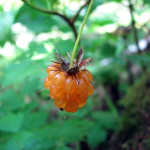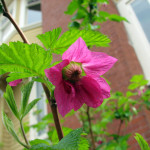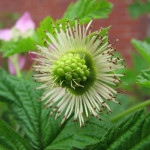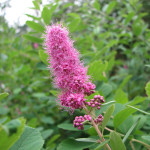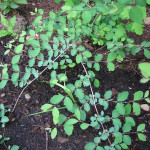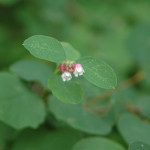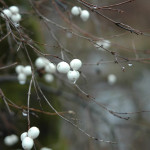Rubus spectabilis
Salmonberry (Rubus spectabilis) is an upright shrub growing to 10 feet tall, with a unique vase-like shape and prickly stems. The purple-magenta flowers bloom April through June. The orange-red, raspberry-like fruit matures in late summer to early autumn.
Salmonberry is a great wildlife plant for a large yard or garden; the open flowers attract bumblebees and hummingbirds while the fruit is a treat for thrushes, tanagers, finches, and wrens. Native bees also use it extensively for nesting material and winter shelter.
Salmonberries grow in moist forest openings and stream margins, so it does best in full sun to part shade and moist to wet soils. They often form large thickets, and thrive in the open spaces under stands of red alder.
- Light Requirements: Full Sun, Part Shade, Full Shade
- Water Requirements: Moist, Seasonally Wet
- Ease of Growing: Easy to grow
- Growth Rate: Moderate
- Spreads: Yes
- Wildlife Support: Pollinators, Hummingbirds, Pest-eating Insects, Birds or Mammals
- Fire-resistant: No
- Edible: Yes
- Mature Height: 4-10ft
- Mature Width:4-10ft
Douglas Spirea
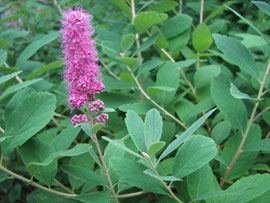
Spiraea douglasii
Also known as hardhack or steeplebush, Douglas spirea (Spiraea douglasii) is best known for its large, pink, pointy clusters of small flowers that bloom from May – July. The flower clusters turn dark in late summer and linger on the plant for months, adding visual interest.
A fast grower that can reach 10-12 feet tall in just a few years, Douglas spirea favors open sunny areas and can tolerate seasonal flooding. It can spread aggressively in moist environments, but is better behaved in drier areas.
Many butterflies visit this plant for nectar and lay their eggs on it, including pale swallowtail, Lorquin’s admiral, spring azure, and mourning cloak.
- Light Requirements: Full Sun, Part Shade
- Water Requirements: Moist, Seasonally Wet
- Ease of Growing: Easy to grow
- Growth Rate: Fast
- Spreads: Yes
- Wildlife Support: Pollinators, Pest-eating Insects, Birds or Mammals
- Fire-resistant: Yes
- Edible: No
- Mature Height: 6ft
- Mature Width:3-7ft
Snowberry
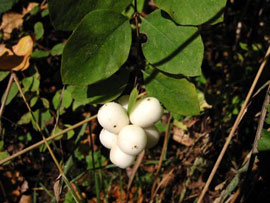
Symphoricarpos albus
Few plants are as aptly named as snowberry. Small bell-like pink flowers give way to scattered clusters of white berries in late summer, which stay on the delicate, arching branches through the fall and much of winter. The small, pale green oval leaves turn a soft yellow in the fall.
Snowberries are at their best in the landscape when combined with other plants. They bring an airy lightness to the understory that contrasts well with the thick evergreen leaves of salal and low Oregon grape, the red stems of red osier dogwoods, and the feathery green foliage of Western hemlock and Western redcedar.
The berries are eaten late in winter by thrushes, towhees, robins, waxwings, and grosbeaks. Anna’s and rufous hummingbirds are attracted to the flowers, as are many species of native bees. Snowberry also provides food for the young of vashti sphinx moths and is generally good cover for wildlife.
Snowberry is tolerant of a wide variety of growing conditions, spreads easily, and makes an excellent addition to any garden.
- Light Requirements: Full Sun, Part Shade, Full Shade
- Water Requirements: Dry, Moist
- Ease of Growing: Easy to grow
- Growth Rate: Fast
- Spreads: Yes
- Wildlife Support: Pollinators, Hummingbirds, Pest-eating Insects, Birds or Mammals
- Fire-resistant: Yes
- Edible: No
- Mature Height: 3-6ft
- Mature Width:2-4ft


